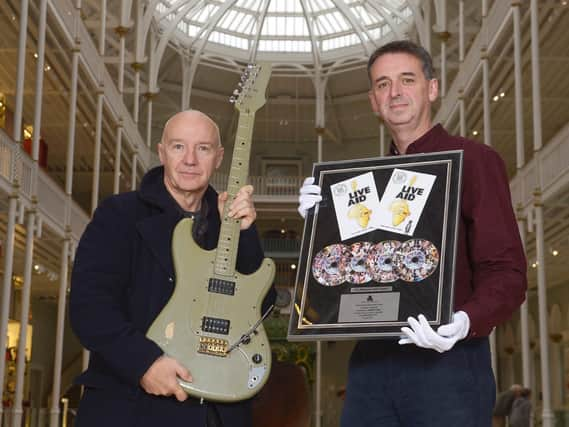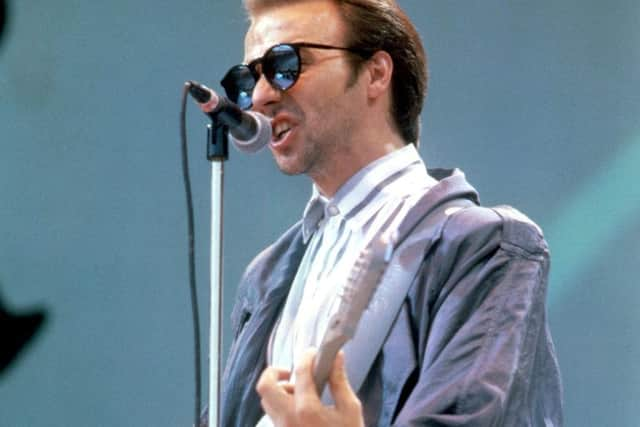National Museum exhibition to chart history of Scottish pop music


The National Museum of Scotland in Edinburgh is joining forces with the BBC to stage an extended celebration of “the musical culture of a nation" next year.
Spanning the 1950s to the present day, it will feature artists ranging from Lonnie Donegan, Lulu, Gerry Rafferty, Midge Ure and The Rezillos to Garbage, Franz Ferdinand and Young Fathers.
Advertisement
Hide AdAdvertisement
Hide AdThe exhibition will explore the influence of some of Scotland’s best-known record labels, including Postcard, Fast Product and Chemikal Underground, and the ground-breaking music they released by Orange Juice, Scars, The Mekons, Mogwai and Arab Strap.


Costumes, musical instruments, stage props, archive footage and newly-recorded interviews will all be featured in the exhibition, which is believed to be the first major celebration of its kind.
The National Museum exhibition, which runs from 22 June-25 November next year, is being staged in the wake of the huge success of David Bowie and Pink Floyd exhibitions, Liverpool's pop music exhibition The Beat Goes On, and the celebrations of AC/DC and Kylie Minogue at Kelvingrove Art Gallery and Museum in Glasgow.
Exhibition curator Stephen Allen said: “Popular music is a shared experience, and a really important one in many people’s lives.
“Whether it’s a gig that a teenager went to a week ago or forty years ago or a song they hear for the first time, a lot of the underlying emotions and reactions are the same.


“We want the exhibition to capture and reflect that in the atmosphere and the experience, to look at it from both a Scottish and wider perspective and, crucially, to put the music and the people who made it centre-stage.
“I’m sure it’ll generate a huge amount of lively debate and discussion.”
Advertisement
Hide AdAdvertisement
Hide AdMidge Ure, who visited the museum today to help the museum promote the exhibition, has agreed to donate two jackets he wore in Ultravox’s Vienna video in 1981 and on stage at the Live Aid concert he helped mastermind in 1985.
He said: “I don’t think there’s ever been an exhibition like this before. I’m not sure how all-encompassing it will be, but as far as I know it will cover a lot of the rock music Scotland has been responsible for over the last 50 or 60 years.
“For a small country we have punched way above our weight when it comes to producing global artists. But I think we’re very good at hiding our lights under a bushel.
“I think the success of the David Bowie and Pink Floyd exhibitions has woken the museum world up a bit to the fact that people want to see this kind of stuff.
“I’m donating the silk coat that I wore to perform at Live Aid. Everyone thought I had lost my marbles wearing it - it’s actually a woman’s coat that I bought in Los Angeles because it was lightweight.
“The other one is the classic Burberry raincoat I wore in the Vienna video. When I first made any money at all I went to Burberry in London and spent £250 on it.”
The exhibition will be accompanied by a three-part TV series and a four-part radio series, which are both being made by BBC Scotland as part of a wide-ranging collaboration with the museum, Scotland's busiest visitor attraction.
Advertisement
Hide AdAdvertisement
Hide AdA series of specially-programmed live performances and talks will also be staged in the city during the six-month run of the exhibition, which will coincide with the Edinburgh International Festival and Fringe, while broadcaster Vic Galloway, who be presenting the radio series, will be writing an official book.
Galloway said: "I'm hoping there will be a huge amount of interest in Scotland itself, as well as across the UK at large. I'd like to think tourists arriving in Edinburgh from all corners of the world will find it fascinating and fun too. The music that has come out of this country across seven decades has been exemplary, and has gone on to influence the whole history of global pop and rock.
"There will be big names, success stories and lesser-known innovators in there. It will reflect the artists themselves, the historical trends of the music industry and the fans, of course. Hopefully everyone who sees the exhibition will be inspired in some way.
"The time seems right just now. Maybe we're at a place in pop history where we're more comfortable looking back as well as looking forward. This is modern-day, popular history after all, and something almost everyone can relate to.
"The Bowie show and other recent music exhibitions have proved how popular they are with audiences of all ages and demographics. Scotland is growing in confidence too, and perhaps beginning to realise its own importance in modern pop culture.
"From Lonnie Donegan, Lulu, Alex Harvey, Gerry Rafferty, The Rezillos, Fire Engines, Simple Minds, Big Country, Eurythmics, The Proclaimers, Teenage Fanclub, Mogwai, Franz Ferdinand, Paolo Nutini, Biffy Clyro right up to Chvrches and Calvin Harris (to name but a few) the list is huge and extremely impressive across all genres of rock and pop.
"It's a story that needs telling and a catalogue of artists we should definitely celebrate. There is no particular halcyon era, either. Scotland's music is more popular and successful today than it has ever been."
Advertisement
Hide AdAdvertisement
Hide AdDavid Harron, commissioning executive at BBC Scotland, said: “This is a significant multi-platform commission for BBC Scotland and we are delighted to be working on it in partnership with the National Museum of Scotland.
“In addition to the landmark TV series of three one-hour episodes we’ll also have compelling content on BBC Radio Scotland and on our digital platforms. It’ll be an exciting journey for our audiences through the fantastic story of Scottish pop, from its roots to the present day.”
Fiona Shepherd, The Scotsman’s pop and rock critic, said: “There’s books written on the history of Scottish pop and rock before, but it’s such a huge subject for an exhibition that it it is maybe been too daunting before. If anyone is going to do it, an organisation as big as the National Museum can. It is such a large canvas.”